
A truss bridge is a bridge whose load-bearing superstructure is composed of a truss, a structure of connected elements, usually forming triangular units. The connected elements may be stressed from tension, compression, or sometimes both in response to dynamic loads. The basic types of truss bridges shown in this article have simple designs which could be easily analyzed by 19th and early 20th-century engineers. A truss bridge is economical to construct because it uses materials efficiently.

The Metal Highway Bridges of Fulton County Thematic Resources is the title for a Multiple Property Submission to the National Register of Historic Places in the U.S. state of Illinois. Originally the submission included nine separate bridges throughout Fulton County; however, since the Metal Highway Bridges' inclusion on the Register in 1980, more than half of those bridges have been destroyed.

Chevelon Creek Bridge is a historic road bridge located about 12 miles (19 km) southeast of Winslow, in Navajo County, eastern Arizona, United States. It is a steel Warren Pony truss bridge over Chevelon Creek, built on the first permanent road connecting Holbrook, the seat of Navajo County, and Winslow. When built, the road was regionally important in northern Arizona as well as being a segment of an early national highway at the time automobile traffic was growing and national roads were first being formed. The bridge was listed on the National Register of Historic Places in 1983 for being a rare design in Arizona, part of an early transnational roadway, one of the first bridges built by Arizona after statehood in 1912, and being in nearly original condition.
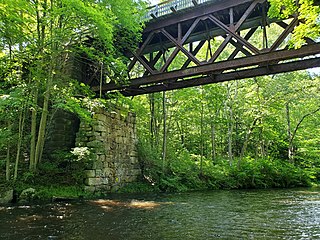
The Blackledge River Railroad Bridge is a Warren truss bridge that was built on the site of a c. 1870 railroad bridge. The original bridge was completed and opened by August 3, 1877. Likely built by the Colchester Railway Company, the bridge was part of the 3.59 miles (5.78 km) of track from Colchester, Connecticut, to Turnerville. The line was leased to the Boston & New York Air Line Railroad and reported improvement in 1879 and a new 110-foot long (34 m) iron bridge by 1881. The line was leased to the New York, New Haven and Hartford Railroad in 1882. After dominating the region, the New York, New Haven and Hartford Railroad petitioned for changes to the Air Line and the approval came on July 7, 1911.

The Upper Paris Bridge is an historic structure located near the town of Coggon in rural Linn County, Iowa, United States. The pin-connected Whipple through truss bridge was built in 1879 as a wagon bridge. It was designed by the Wrought Iron Bridge Company of Canton, Ohio. The bridge was listed on the National Register of Historic Places in 1998 as a part of the Highway Bridges of Iowa MPS.

The Capon Lake Whipple Truss Bridge, formerly known as South Branch Bridge or Romney Bridge, is a historic Whipple truss bridge in Capon Lake, West Virginia. It is located off Carpers Pike and crosses the Cacapon River. The bridge formerly carried Capon Springs Road over the river, connecting Capon Springs and Capon Lake.
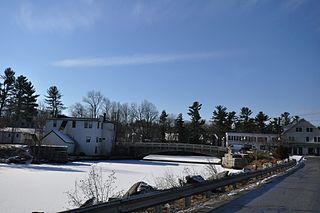
The Goffstown Covered Railroad Bridge was a rare railroad covered bridge in Goffstown, New Hampshire. It was built in 1901 by the Boston and Maine Railroad, on the site of an earlier bridge built in 1850 by the New Hampshire Central Railroad, and carried its tracks across the Piscataquog River in the center of Goffstown. The bridge was listed on the National Register of Historic Places in 1975. It was destroyed by arson in 1976, as would later be the case with the Hillsborough Railroad Bridge in 1985.
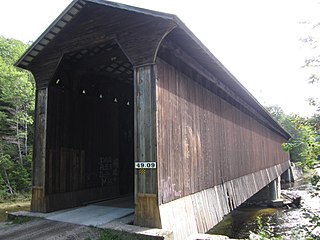
Wright's Bridge is a historic covered bridge in Newport, New Hampshire. Originally built in 1906 to carry the Boston and Maine Railroad across the Sugar River, it now carries the multi-use Sugar River Trail. The bridge was listed on the National Register of Historic Places in 1975.

The Tilton Island Park Bridge is a foot bridge in Tilton, New Hampshire. It spans a portion of the Winnipesaukee River just east of downtown Tilton, providing access to Tilton Island Park, located on an island in the river. Built in 1881, it is a rare surviving example of a bridge with cast iron components, designed by a distinctive patent issued in 1858 to Lucius Truesdell. The bridge was listed on the National Register of Historic Places in 1980.
The US 62 Bridge over Crooked Creek is a historic bridge near Pyatt, Arkansas. It carries US Highway 62 (US 62) and US 412 across Crooked Creek, which flows through the center of Pyatt to the northwest.

The Robyville Bridge is a historic covered bridge in Corinth, Maine. Built in 1876, this Howe truss bridge is one of the state's few surviving 19th-century covered bridges. It carries Covered Bridge Road across Kenduskeag Stream in the southern part of the rural community. It was listed on the National Register of Historic Places in 1970 and designated as a Maine Historic Civil Engineering Landmark by the American Society of Civil Engineers in 2002.
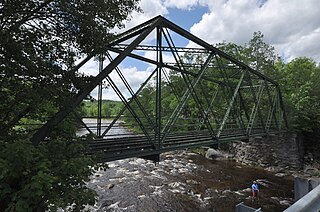
The Medburyville Bridge is a historic bridge in Wilmington, Vermont. It is a steel Warren through bridge, built in 1896 across the Deerfield River, just south of Vermont Route 9 roughly midway between the centers of Wilmington and Searsburg. It stands just upstream of the Woods Road bridge, which functionally replaced it in 1985. The bridge was listed on the National Register of Historic Places in 1990; as it has no decking, it is closed to all forms of traffic.

The Williams River Route 5 Bridge is a historic Warren deck truss bridge, carrying U.S. Route 5 (US 5) across the Williams River in Rockingham, Vermont. Built in 1929 and rebuilt in 1971-72, it is one of four bridges of this type and vintage in the state. It was listed on the National Register of Historic Places in 1991.

Bridge 22, also known as the Creamery Bridge is a historic pony truss bridge, carrying Old Creamery Road across the Waits River in Bradford, Vermont. Built in 1934, it is well-preserved late example of a bridge style then passing out of fashion. It was listed on the National Register of Historic Places in 2010.

The Ottauquechee River Bridge is a steel girder bridge carrying United States Route 5 across the Ottauquechee River in Hartland, Vermont. The bridge replaced a c. 1930 Warren deck truss bridge, built in the wake of Vermont's devastating 1927 floods, and listed on the National Register of Historic Places in 1990.

The Foundry Bridge is a historic Warren pony truss bridge, carrying Foundry Road across the First Branch White River in Tunbridge, Vermont. Built in 1889, it is one of the state's oldest wrought iron bridges, and the only surviving example in the state of work by the Vermont Construction Company, its only local manufacturer of such bridges. It was listed on the National Register of Historic Places in 2007.

The Woodstock Warren Through Truss Bridge was a historic iron bridge that carried Bridges Road across the Ottauquechee River in western Woodstock, Vermont. The bridge was built in 1925, and was a rare example of the state of a double-intersection Warren through truss. The bridge was swept away by flooding caused by Hurricane Irene in 2011; it was listed on the National Register of Historic Places in 1992.

The New Haven-Weybridge Rattling Bridge is a historic bridge spanning Otter Creek between the Vermont towns of Weybridge and New Haven. It connects Town Highway 7 in New Haven with Town Highway 11 in Weybridge. Built in 1908 by the American Bridge Company, it is a well-preserved example of a rivet-connected lattice truss bridge. It was listed on the National Register of Historic Places as Bridge 26 in 2006.

The Lover's Lane Bridge is a historic bridge spanning the Dog River in Berlin, Vermont. Built in 1915, it is a rare early 20th-century example of a Warren pony truss bridge. It was listed on the National Register of Historic Places in 2006 as Bridge No. 27.
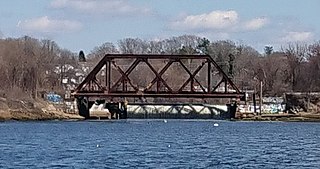
The Omega Pond Railroad Bridge is a railroad bridge spanning the western end of Omega Pond in East Providence, Rhode Island. The bridge is a contributing structure to the Phillipsdale Historic District listed on the National Register of Historic Places.





















